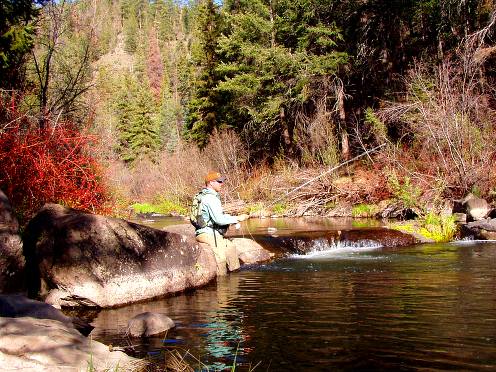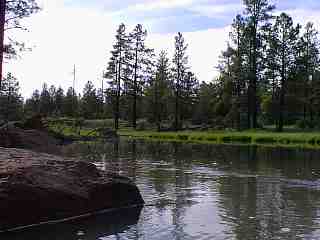|
|
RESOURCES
Resources: Annual Reports | Newsletters | Fact Sheets | Reports & Proposals | Links | Press Releases
FACT SHEET
Arizona Roadless Areas, Trout Habitat, and Fishing
Current Road and Roadless Conditions
- National Forest System (NFS) lands in Arizona have more than 28,720 miles of roads, 6.53% of all NFS roads in the country, and more than enough miles of roads to reach around the circumference of the earth. Over 380,000 miles of mapped roads and 60,000 miles unmapped logging roads currently exist in the NFS, enough to reach the moon with more than 40,000 miles left over. 1
- There is currently a $190.7 million cumulative road maintenance backlog on NFS roads within Arizona. Of the 28720 miles of roads on Arizona’s national forests, only 3,025 miles receive annual maintenance. The annual maintenance backlog is $24.6 million, with roads receiving only 20.4% of the maintenance budget needed to keep them safe and usable. The current national NFS road maintenance backlog is $8.4 billion.
- Arizona has 1.174 million acres in Inventoried Roadless Areas, which is 10.4% of the 11.255 million total acres in six national forests in the state. 2
Roads and Native and Introduced Trout 
- The Arizona Game & Fish Department (Department) reports that the principal trout species of concern to anglers in roadless areas are native Apache and, Gila trout and introduced rainbow and brown trout. Apache and Gila trout are federally listed species that are largely confined to higher elevation streams with high water quality and habitat that has not been degraded.
- Gila trout in Arizona are currently found only in Raspberry Creek in the Apache-Sitgreaves National Forest and Dude Creek in the Tonto National Forest.
- Threats to Gila trout are comparable to those identified for other trout species in other interior North American headwater streams--competition, predation, and hybridization with introduced rainbow, brook and brown trout, habitat loss and degradation, fragmentation of range, and decreased water quality and quantity. 3
- The Apache trout, Arizona’s State Fish, is found only in Arizona and mostly in the White Mountains on the Apache-Sitgreaves National Forest and the Fort Apache Indian Reservation. Apache trout also occur in North Canyon Creek in the Saddle Mountain Wilderness north of Grand Canyon. Restoration efforts for Apache trout in Fish Creek are underway, and Centerfire Creek and the West Fork of the Little Colorado River will be renovated in the near future. These and other streams are important habitat for
 Apache trout. 4 Apache trout. 4
- Restoration of native Gila and Apache trout is planned for streams and lakes both in and out of roadless areas. Streams in roadless areas often have the high water quality, stable streamflow and water supplies and undegraded habitat that make them suitable for native trout restoration.
- The Department also stocks non-native rainbow, brown and brook trout and arctic grayling to support backcountry sportfishing.
- Brown trout are found in streams and some lakes in the White Mountains and around the Mogollon Rim country.
- Cutthroat trout are introduced and mostly occur in the White Mountain lakes stocked by the Department. They prefer the same habitat as rainbow trout and are found in similar areas. 5
- Roadless areas act as a barrier against noxious invasive plant and animal species and as strongholds for native fish populations due to cumulative degradation and loss of downstream aquatic habitats. 6
- A study on the Clearwater National Forest in Idaho found that much of the best fish habitat in streams is in unroaded areas where levels of fine streambed sediment are lower than in managed landscapes. In general, increasing road density results in declining pool frequency from fine sediments filling pools. Pool habitat is essential to stream-dwelling trout for overwintering habitat, thermal refuge and foraging areas. 7
- There is a negative correlation between increasing road densities and viable redband rainbow trout, and Yellowstone and westslope cutthroat trout populations in the Columbia River Basin in the Northwest U.S., an area with 144 million acres, 7 states and 35 National Forests. 8
- Road construction can result in significant loss of biological diversity at both local and regional scales due to: 1) restricted movement of species between local populations; 2) increased mortality; 3) habitat fragmentation and edge effects; 4) invasion by exotic species; and 5) increased human access to wildlife habitats, all of which are expected to increase local extinction rates or decrease local recolonization rates. 9
- Fishing in Arizona has a direct economic value of more than $831 million based on 5.3 million angler days in 2001 (Silberman 2003). 10
The Message from Hunters And Anglers Today
The prevailing message from the hunters and anglers is “Leave things as they are now. Don’t build new roads into roadless areas, but make sure hunters and anglers have access to national forest lands and roadless areas.”
Sources of Information
- 1996 Report of USDA Forest Service
- http://roadless.fs.fed.us/states/az/state3.shtml
- Platania, S.P. 1998. Perils Facing the Gila Trout. In Mac, M.J., et al. Status and Trends of the Nation’s Biological Resources. U.S.D.I., Geological Survey. 964 pp. See http://biology.usgs.gov/s+t/SNT/noframe/sw157.htm.
- Arizona Game & Fish Department. Apache Trout Recovery at http://www.azgfd.gov/w_c/apache_recovery.shtml.
- Arizona Game & Fish Department. Cutthroat Trout at http://www.gf.state.az.us/h_f/fish_cutthroat_trout.shtml.
- Jim Lyons, Under Secretary of Agriculture, testimony to the U.S. House of Representatives. March 14, 2000
- Huntington, C.W. 1995. Fish Habitat and Salmonid Abundance Within Managed and Unroaded Landscapes on the Clearwater National Forest, Idaho.
- Lee, D.C., J.R. Sedell, B.R. Rieman, R.F. Thurow and J.E. Williams. 1997. An assessment of ecosystem components in the Interior Columbia Basin and portions of the Klamath and Great Basins: Volume 3, pp. 1058-1496. Gen. Tech. Rep. PNW-GTR-405. USDA Forest Service, Pacific Northwest Research Station, Portland, OR.
- Findlay, C.S. and J. Bourdages. 2000. Response time of wetland biodiversity to road construction on adjacent lands. Conservation Biology 14:86-94.
- Silberman, J. 2003. The economic importance of fishing and hunting: economic data on fishing and hunting for the State of Arizona and for each Arizona county. Arizona State University West, Phoenix.
This fact sheet was compiled by the Theodore Roosevelt Conservation Partnership.
The Theodore Roosevelt Conservation Partnership is a coalition of leading conservation organizations and individual grassroots partners, working together to expand access to places to hunt and fish, conserve fish and wildlife and their habitat, and increase funding for conservation and management.
|

